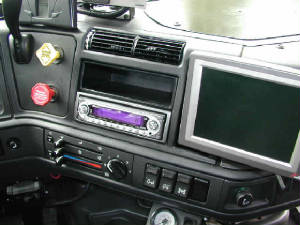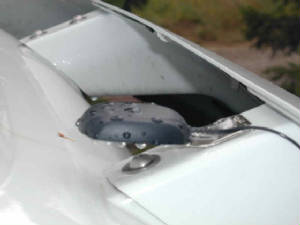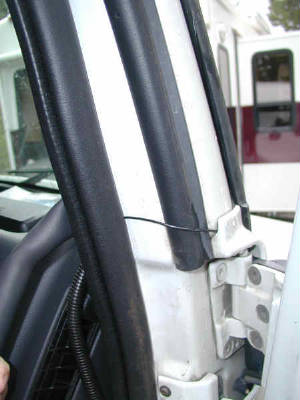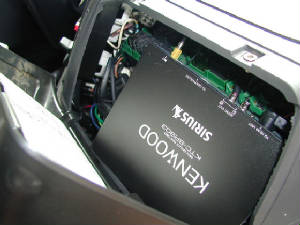The stock Delco radio that was in our Volvo was not a very good radio, and it did not have a CD player, only a cassette
player. We upgraded the radio to a Kenwood KDC-MP6025. It has an inbuilt Sirius display/controls with an external "brain"
box (the satellite tuner). I chose Sirius over XM because the general consensus is that you get less drop outs with Sirius.
This is because of the location of the Sirius satellites, and the fact that there are at least 2 satellites visible in any
location vs. a single satellite with XM. The XM satellites are in geo synchronous orbit (like the DirecTV and Dish Network
satellites). The Sirius satellites do figure 8's over the US. At least in theory, the Sirius satellites should provide better
reception.
I looked at the external satellite radio receivers that can be moved from the truck to the trailer, or
into another vehicle. I chose the integrated display (built into the radio) primarily because I have no need to move the receiver/display
and I definitely don't need another box on my dash. It is getting crowded as is.
The radio is an upper line radio.
It has 25 watts x 4 RMS of power, which makes a remarkable difference in the listening experience. I am definitely NOT an
audiophile, so my requirements are not as strict as some. But the difference between the radios is both readily apparent,
and huge. I thought I would have to upgrade the stock speakers, but this radio makes such a difference I probably will not
do it. I may add an amp and subwoofer later and keep the existing speaker set. You can always use the extra bass. If I did
this, I would leave the front speakers powered by the radio, and move the rear speakers to the amp.
Installation
The Sirius satellite tuner box went in the space right behind the cup holders - vertically. There is 20 feet
of cable from the radio to the satellite tuner box, so you can locate it pretty much anywhere. The limiting factor in location
was the amount of antenna coax supplied with the magnetic base antenna. There was just enough antenna wire to reach from the
roof to the cupholder. Since the tuner does not generate heat, it is OK to mount it here. It is easily removed for servicing,
or to move it to another vehicle if I sell the Volvo.
The antenna mounted on the passenger side visor brace (on an
existing screw), on a piece of metal stock for horizontal magnetic mounting. It is important to maintain a horizontal position
for the antenna. The tiny coax was run through the visor light trim piece towards the passenger side. I used white silicon
caulk to secure it where required. It then runs downward behind the vertical windshield trim to the door hinge area where
a piece of horizontal trim allows it to enter the door area without exposure. It proceeds through the rubber door trim and
along the front of the dash. It is not visible. It enters the dash through the Eaton autoshift wire run, and then across to
the fuse center (behind the cup holder)to the tuner box. The whole thing is neat, and took half an hour - start to finish.
The radio went in just as easy.
Sirius Reception
Sirius reception is 100% so far - and
I've been trying to beat it. There are no directional issues (truck facing certain directions) with the mounting location
on the visor, and the truck roof, which rises steeply behind the visor, does not interfere with signal acquisition. The antenna
is not visible from the ground. (One note on the visor mounting position - it worked well on a Volvo 610, with a mid-height
roof. I'm not sure that it would work as well on a full-height truck because of the additional cab above the visor.) In areas
where XM is known to lose signal (like 4th of July Pass in Idaho) I have no problems. I have also driven on densely treed
two lane roads, where the trees are right up to the road edge. Again, no reception problems. Another thing I've noticed -
in heavy rain there are no drop outs like with satellite TV. So I guess that the Sirius birds are helping me out.
I
now know why people love satellite radio, although I never thought I would. But the sound quality is NOTICABLY better than
over the air music, even to a non-audiophile like me. So, I guess I'm a happy camper.
Here are the Volvo wire id's for the speakers (from Joe Johnson):
490 - Radio/CD Radio Feed (Power)
491 - CD Radio Power Stud Feed
492 - Radio Battery Feed
497L+ - Door Speaker Left, Positive
497L- - Door Speaker Left, Negative
498LR+ - Rear Speaker, Left, Positive
498LR- - Rear Speaker, Left, Negative
498RR+ - Rear Speaker, Right, Positive
498RR- - Rear Speaker, Right, Negative
499LF+ - Front Speaker, Left, Positive
499LF- - Front Speaker, Left, Negative
499RF+ - Front Speaker, Right, Positive
499RF- - Front Speaker, Right, Negative
L+ - Lover Left Rear, Positive
L- - Lower Left Rear, Negative
R+ - Lover Right Rear, Negative
R- - Lower Right Rear, Negative
S1+ - Subwoofer Coil 1, Positive
S1- - Subwoofer Coil 1, Negative
S2+ - Subwoofer Coil 2, Positive
S2- - Subwoofer Coil 2, Negative
You may find that your rear speaker wires read 498LA, 498LB, 498RA and 498RB.
| The New Radio |

|
| Antenna Mounted on Visor |

|
| Note bracket which maintains horizontal plane |
| Antenna coax entry to cab |

|
| This is the only visible exposure of coax |
| The "brain" of the Satellite receiver |

|
| Fits fine here loose. Heat is no problem. (That is not a wire on the R audio out.) |

